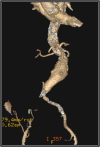Abdominal endovascular aneurysm repair using an aorto-uni-iliac device resulting in resting lower extremity pain: a case report and discussion on patient selection
- PMID: 39211369
- PMCID: PMC11358055
- DOI: 10.1093/jscr/rjae557
Abdominal endovascular aneurysm repair using an aorto-uni-iliac device resulting in resting lower extremity pain: a case report and discussion on patient selection
Abstract
Abdominal aortic aneurysms that meet criteria for repair are often managed with endovascular aneurysm repair using a bifurcated two-piece or bifurcated single-body stent. Patients with difficult anatomy, extensive calcifications, complete occlusion of common or external iliac artery, tortuous vessels, or small vessels may require placement of an Aorto-Uni-Iliac (AUI) stent graft. Placement of an AUI stent graft is typically combined with a femorofemoral crossover bypass to ensure adequate perfusion to the contralateral limb. In the elective setting, some literature now supports that select patients with unilateral occlusive common or external iliac disease may be treated with an AUI stent graft alone without femorofemoral crossover bypass. Here, we present a case of a 79-year-old female with an abdominal aortic aneurysms with unilateral occlusive iliac disease managed with an AUI stent graft who subsequently developed rest pain requiring a femorofemoral crossover bypass.
Keywords: AUI; FCB; aorto-mono-iliac; aorto-uni-iliac; aorto-uni-iliac stent graft; femorofemoral crossover bypass.
Published by Oxford University Press and JSCR Publishing Ltd. © The Author(s) 2024.
Figures
Similar articles
-
Aorto-uni-iliac stent grafts without crossover fem-fem bypass for treatment of abdominal aortic aneurysms: A report of two cases.Int J Surg Case Rep. 2024 Aug;121:109918. doi: 10.1016/j.ijscr.2024.109918. Epub 2024 Jun 21. Int J Surg Case Rep. 2024. PMID: 38954972 Free PMC article.
-
Using bifurcated endoprosthesis after iliac artery recanalization for concomitant abdominal aortic aneurysm and chronic total occlusions of access routes.J Vasc Surg. 2019 Jul;70(1):117-122. doi: 10.1016/j.jvs.2018.08.191. Epub 2018 Dec 13. J Vasc Surg. 2019. PMID: 30553731
-
Early complications of femorofemoral crossover bypass grafts after aorta uni-iliac endovascular repair of abdominal aortic aneurysms.J Vasc Surg. 1998 Oct;28(4):647-50. doi: 10.1016/s0741-5214(98)70089-8. J Vasc Surg. 1998. PMID: 9786259
-
Endovascular repair of abdominal aortic aneurysm with severely angulated neck and tortuous artery access: case report and literature review.BMC Surg. 2015 Mar 8;15:20. doi: 10.1186/s12893-015-0005-5. BMC Surg. 2015. PMID: 25887163 Free PMC article. Review.
-
A novel hybrid approach to the treatment of common iliac aneurysms: antegrade endovascular hypogastric stent grafting and femorofemoral bypass grafting.J Vasc Surg. 2007 Jun;45(6):1244-8. doi: 10.1016/j.jvs.2007.01.052. J Vasc Surg. 2007. PMID: 17543689 Review.
References
Publication types
LinkOut - more resources
Full Text Sources



